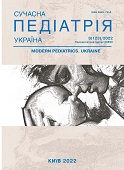The polymyelite problem: a threat or a reality?
DOI:
https://doi.org/10.15574/SP.2022.123.47Keywords:
children, polio, diagnosis, differential diagnosisAbstract
The relevance of infectious pathology in children in modern conditions has acquired new significant features. We are talking about the measles epidemic (2017–2019), then the incidence and mortality caused by the Covid-19 virus (since 2020), and now (autumn 2021–January 2022) – an outbreak of polio in Ukraine. Already in January 2022, the second case of polio in a child from Ukraine was confirmed, so we have two outbreaks (Rivne and Zakarpattia regions), where the level of vaccination is the lowest in the country. And it is one of the lowest in the Zakarpattia region, and the tendency to further decrease has been observed for the last 2 years. It was found that the children were infected with the second type of poliovirus. This has greatly alarmed ukrainian and foreign experts, as the previous active campaign on global vaccination has reduced the number of polio cases in the world by 99% (for the period 1988-2021). The risk of polio in Ukraine is still high. These circumstances motivate to update the knowledge of doctors on diagnostic issues, differential diagnosis, to improve the quality of diagnosis.
In the context of a decrease in the activity of the vaccine company, a high percentage of asymptomatic course and carriers of the polio virus, difficulties in differential diagnosis, and the absence of etiopathogenetic therapy, the threat of the spread of this dangerous infection among the child population with serious long-term consequences is obvious. The only step that can make a real difference is the introduction of active action to close the gap in routine immunization coverage for children.
No conflict of interests was declared by the author.
References
Beyker KDzh. (2019). Atlas dytyachykh infektsiynykh khvorob.Chervona knyha. Kyiv:VSV «Medytsyna»: 744.
Chernyshova LI. (2015). Stratehichni napryamky profilaktyky poliomiyelitu (lektsiya). Suchasna pediatriya. 5 (69): 14-17. https://doi.org/10.15574/SP.2015.69.14.
Kuryshko D. (2022). Skalicheni dity. Yak poliomiielit zahrozhuie Ukraini. BBC News. URL: https://www.bbc.com/ukrainian/features-59786629.
Messacar K, Benson L, Bove R et al. (2020). Acute flaccid myelitis: cause, diagnosis, and management. The Lancet. 397: 334-346.
Mishra P, Meissner HC. (2020). Acute flaccid myelitis: Another troubling emerging infectious disease. URL: https://publications.aap.org/aapnews/news/7330.
MOZ Ukrainy. (2021). Plan zakhodiv z reahuvannia na spalakh tsyrkuliuiuchoho vaktsynosporidnenoho poliovirusu typ 2. Nakaz MOZ Ukrainy No. 2922 vid 30.12.2021. URL: https://phc.org.ua/news/plan-zakhodiv-dlya-zakhistu-ditey-vid-poliomielitu-v-ukraini-zatverdzheno.
MOZ Ukrainy. (2022). Zahalni dani shchodo okhoplennia shcheplenniamy po Ukraini. Tsentr hromadskoho zdorovia MOZ Ukrainy. URL: https://www.phc.org.ua/kontrol-zakhvoryuvan/imunizaciya/okhoplennya-scheplennyami.
Orenstein WA. (2015). Eradicating Polio: How the World’s Pediatricians Can Help Stop This Crippling Illness Foreve. Pediatrics. 135 (1): e20143163. https://doi.org/10.1542/peds.2014-3163.
UNICEF. (2022). Poliomiielit povernuvsia v Ukrainu. URL: https://www.unicef.org/ukraine/stories/polio-has-returned-to-ukraine.
UNICEF. (2022). Ukrainskykh batkiv zaklykaiut vaktsynuvaty vid poliomiielitu ditei, yaki propustyly shcheplennia. URL: https://www.unicef.org/ukraine/press-releases/polio-briefing.
Downloads
Published
Issue
Section
License
Copyright (c) 2022 Modern pediatrics. Ukraine

This work is licensed under a Creative Commons Attribution-NonCommercial 4.0 International License.
The policy of the Journal “MODERN PEDIATRICS. UKRAINE” is compatible with the vast majority of funders' of open access and self-archiving policies. The journal provides immediate open access route being convinced that everyone – not only scientists - can benefit from research results, and publishes articles exclusively under open access distribution, with a Creative Commons Attribution-Noncommercial 4.0 international license (СС BY-NC).
Authors transfer the copyright to the Journal “MODERN PEDIATRICS. UKRAINE” when the manuscript is accepted for publication. Authors declare that this manuscript has not been published nor is under simultaneous consideration for publication elsewhere. After publication, the articles become freely available on-line to the public.
Readers have the right to use, distribute, and reproduce articles in any medium, provided the articles and the journal are properly cited.
The use of published materials for commercial purposes is strongly prohibited.

